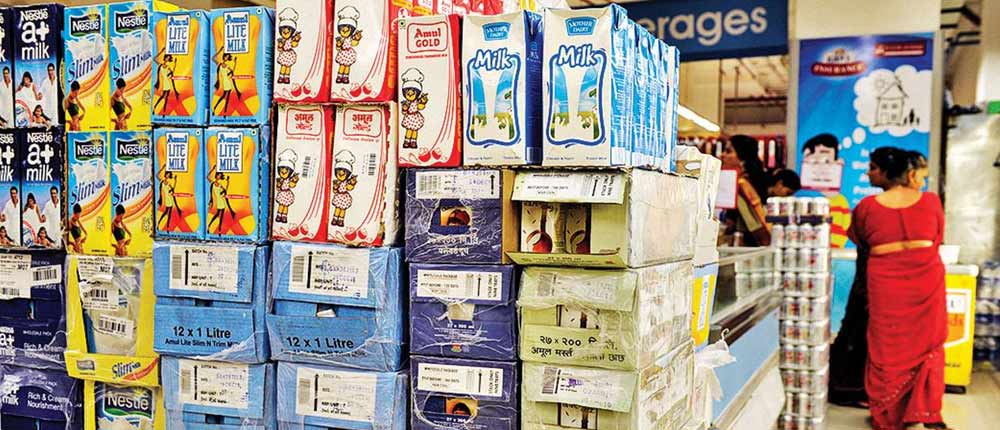Study recommends a well established value chain for collectors and awareness among recyclers of the potential of cartons

Tetra Pak cartons are primarily made from paper, and are composed of 75% paperboard, 20% polyethylene, and 5% aluminium. As part of environmental initiatives, Tetra Pak has undertaken various activities for collecting and recycling Post-Consumer Tetra Pak Cartons and is working with non-governmental organizations (NGOs) and waste pickers to segregate PCCs. TERI undertook this study in 2015 funded by Tetra Pak to explore the collection and recycling practices of Post-Consumer Tetra Pak Cartons (PCCs) and the quantum of Tetra Pak cartons procured/retrieved by waste dealers. The study also aims to assess the actual quantum of PCCs reaching paper mills that recycle paper from low-grade paper waste and fate of pulping rejects. Value chain and economics in collection and recycling have also been studied as part of the activity. These studies helped in understanding the quantity of Post-Consumer Tetra Pak Cartons reaching dumpsites. Ultimately, this predicts the needs to upscale collection and recycling: economics, awareness, and infrastructure.
The survey design was comprehensive and exhaustive to capture the overarching scope and facilitate the objectives of the study. Survey partners were identified in each of the identified cities for conducting survey as per the scope given to them. They were asked to take photographs and film the critical parts of the sampling exercise. TERI professionals visited each survey partner in their respective city to guide the survey teams and supervise the exercise. The study revealed that the Post-Consumer Tetra Pak Cartons are collected by rag-pickers, small scale waste paper dealers, large scale dealers and sent to recycling units. Kolkata, Guwahati and Hyderabad revealed that 100% of the respondents at all three levels were dealing in Post-Consumer Tetra Pak Cartons.
Samples at large scale waste dealers were analyzed as per the scope of survey and revealed more than 10% fraction of Post-Consumer Tetra Pak Cartons in waste paper bales in cities of Bangalore, Dhaka. The possible reasons for high fraction of Post-Consumer Tetra Pak Cartons in these two cities is attributed to high price and acceptability for recycling of Post-Consumer Tetra Pak Cartons in both the cities which even attracts small waste dealers from outside city to sell Post-Consumer Tetra Pak Cartons to large scale dealers.
Survey revealed that in cities of Kolkata and Guwahati Post-Consumer Tetra Pak Cartons was treated before selling by separating aluminium and paper, and aluminium was sold at a high price of Rs 45 to Rs 60 per Kg. The recycling rates were worked out with two scenarios of 26% and 29% recovery rates by informal sector revealing an overall recycling rate of 42.85 percent and 45.52 percent respectively. Study also revealed that PCCs reaching paper mills was 0.36 percent of the total paper received by the mill. On an average PCCs reaching dumpsite was 0.343 percent of total waste reaching dumpsite.
Based on the study conducted TERI recommends the following:
- PCC management can be effectively increased in cities with no or low market by developing markets in these cities. Active recycling has significant contribution in the overall recycling of PCCs. Hence, efforts should be made to upscale the capacity of the existing collection centres and to install more such centres in other cities.
- PCC management can be more efficient if the chain is small and there is better price in the market for the collectors.
- Awareness among recyclers about the potential for using PCCs is important. This should be done by highlighting statistics and case studies of mills consuming PCCs for paper production.
- R&D should be carried out for efficient technologies for separating paper from PCCs and usage of polyethylene and aluminium recovered thereafter. Paper mills and recyclers should also be involved so as to create a better market.
- Kolkata, Guwahati, Hyderabad and Chennai reported the highest informal recycling rate for PCCs. Many ragpickers in Kolkata and Guwahati reported that they separated paper and aluminium from the PCCs before selling them to kabadiwalas. The management of PCCs should be further studied and lessons should be replicated at other places along with proper environmental pollution control measures.
- Such an exercise (to study the management of PCCs in major cities and identify the recycling rates) may be repeated in every 3 years to assess the improvement in recycling rates.
